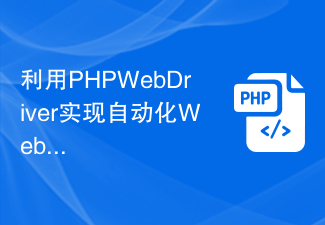PHP is a popular programming language that is widely used in the field of web development and application development. As software development becomes increasingly complex, developers need better tools to help them build reliable and robust applications. Automated testing and BDD are two popular testing methods that help developers find and solve problems during code development. In this article, we will learn about the concepts and practices of automated testing and BDD in PHP.
What is automated testing?
Automated testing is a process of replacing manual testing with software programs. It provides a consistent, reliable and efficient testing approach across application development at different scales. Automated testing can automatically execute a series of tests to evaluate and verify the functionality of the application. It can check for bugs, performance issues, security vulnerabilities and code-prone problems to ensure the high quality of the application.
In PHP, we can use a variety of tools and frameworks to create automated tests. PHPUnit is the most popular PHP unit testing framework. It allows developers to write test cases to test PHP code. There are also other tools such as Behat, Codeception, and PhantomJS that can be used for different types of testing.
Unit testing is the most common type of automated testing, used to test whether individual units of code are valid. Units can be functions, methods, classes, etc. Tests run inside PHPUnit, generate the required PHP objects and runtime environment, and run from the command line or CI tool. Developers can simulate different scenarios and inputs in unit tests to prove the correctness and robustness of their code.
In addition, there are other types of tests in PHP such as integration testing and interface testing, which can be used to verify whether the integration between the various components of the application is effective and the interaction between the application and other systems.
What is BDD?
BDD (Behavior-Driven Development) is a test-driven development method. It emphasizes that the behavior of the code should be defined from the perspective of the application user. Developers and business actors can use BDD to jointly define business logic and application behavior to better understand and test various aspects of the application.
In BDD, developers use the Given-When-Then (given-when-then) format to describe scenarios and use cases. Each scenario includes a description and expected results. Under given conditions, when something happens, then a specific result should occur. BDD ensures that code meets business logic and application requirements.
In PHP, Behat is a widely used BDD testing framework. Developers can use Behat to write natural language presentations for acceptance testing in PHP applications. Put the "Given-When-Then" use case overview in a file ending with .feature, and the specific implementation is completed by the Step Definitions file in the Behat framework. In this way, developers can better understand the operation and execution flow of the code, and express and manage functions in a simple and understandable way.
Conclusion
Automated testing and BDD are two key technologies in PHP, both providing developers with convenient ways to build reliable applications and verify their functionality. Developers can use the PHPUnit framework for unit testing and other types of automated testing and the Behat framework for BDD testing. These techniques can also be implemented early in the development process to identify issues faster and reduce rework. With the help of these tools, PHP developers can build high-quality applications with greater confidence, meet the needs of users and stay ahead of competitors.
The above is the detailed content of Automated testing and BDD in PHP. For more information, please follow other related articles on the PHP Chinese website!
 使用Go语言编写自动化测试样例Jun 03, 2023 pm 07:31 PM
使用Go语言编写自动化测试样例Jun 03, 2023 pm 07:31 PM随着软件开发的迅速发展,自动化测试在开发过程中扮演着越来越重要的角色。相较于人工测试,自动化测试可以提高测试的效率和准确性,减少交付的时间和成本。因此,掌握自动化测试变得非常必要。Go语言是一门现代化的、高效的编程语言,由于其特有的并发模型、内存管理和垃圾回收机制,使得它在Web应用、网络编程、大规模并发、分布式系统等领域有着广泛的应用。而在自动化测试方面,
 微服务架构中如何处理服务的自动化测试和部署?May 17, 2023 am 08:10 AM
微服务架构中如何处理服务的自动化测试和部署?May 17, 2023 am 08:10 AM随着互联网技术的快速发展,微服务架构也越来越被广泛应用。使用微服务架构可以有效避免单体应用的复杂度和代码耦合,提高应用的可扩展性和可维护性。然而,与单体应用不同,在微服务架构中,服务数量庞大,每个服务都需要进行自动化测试和部署,以确保服务的质量和可靠性。本文将针对微服务架构中如何处理服务的自动化测试和部署进行探讨。一、微服务架构中的自动化测试自动化测试是保证
 面向未来的AI自动化测试工具Apr 08, 2023 pm 05:01 PM
面向未来的AI自动化测试工具Apr 08, 2023 pm 05:01 PM译者 | 陈峻审校 | 孙淑娟近年来,自动化测试已经发生了重大的迭代。它在很大程度上协助QA团队减少了人为错误的可能。虽然目前有许多工具可以被用于自动化测试,但合适的工具一直是自动化测试成败与否的关键。同时,随着人工智能、机器学习和神经网络在各个领域的广泛运用,面向人工智能的自动化测试也需要通过合适的工具,来承担重复性的工作,以节省项目团队宝贵的时间,去执行更加复杂和关键的任务。下面,我将和您深入探讨面向未来的AI自动化测试工具。什么是人工智能(AI)自动化测试?AI自动化测试意味着现有的软件
 Gin框架中的API文档和自动化测试详解Jun 22, 2023 pm 09:43 PM
Gin框架中的API文档和自动化测试详解Jun 22, 2023 pm 09:43 PMGin是一个用Golang编写的Web框架,它具有高效、轻量、灵活等优点,性能相对较高,并且易于使用。在Gin框架开发中,API文档和自动化测试十分重要。本文将深入探讨Gin框架中的API文档和自动化测试。一、API文档API文档用于记录所有API接口的详细信息,方便其他开发人员使用和理解。Gin框架提供了多种API文档工具,包括Swagger、GoSwa
 go-zero的集成测试:实现API服务的自动化无损测试Jun 22, 2023 pm 02:06 PM
go-zero的集成测试:实现API服务的自动化无损测试Jun 22, 2023 pm 02:06 PM随着互联网企业的不断壮大,软件开发的复杂性越来越高,测试工作也越来越重要。为了保证程序的正确性和稳定性,必须进行各种类型的测试。其中自动化测试是一种非常重要的方式,它可以提高测试工作效率,减少错误率,并且允许重复执行测试用例以便早发现问题,但是在实际操作过程中,我们也会遇到种种的问题,比如测试工具的选择、测试用例的编写以及测试环境的搭建等问题。go-zero
 利用PHP WebDriver实现自动化Web UI测试的最佳实践Jun 16, 2023 am 09:18 AM
利用PHP WebDriver实现自动化Web UI测试的最佳实践Jun 16, 2023 am 09:18 AM随着Web应用程序的普及和互联网的飞速发展,WebUI测试已经成为软件开发过程中不可忽视的一环。自动化WebUI测试是提高测试效率,缩短项目周期的有效手段。本文将介绍利用PHPWebDriver实现自动化WebUI测试的最佳实践。一、什么是PHPWebDriver?PHPWebDriver是一个基于WebBrowserAutomationA
 Vue项目的自动化测试工具及其使用方法Jun 09, 2023 pm 04:14 PM
Vue项目的自动化测试工具及其使用方法Jun 09, 2023 pm 04:14 PM随着Vue技术的不断发展,越来越多的企业开始使用Vue来开发前端应用。但是,在开发过程中,如何保证代码的质量和稳定性呢?这时候,自动化测试就成为了必不可少的一环。本文将介绍Vue项目中的自动化测试工具及其使用方法,帮助开发者更好地进行测试和验证。一、自动化测试的概述自动化测试是指使用自动化工具来执行测试方案,并发布测试结果。与手动测试相比,自动化测试可以更快
 UniApp实现自动化测试与性能监控的配置与使用指南Jul 04, 2023 pm 12:28 PM
UniApp实现自动化测试与性能监控的配置与使用指南Jul 04, 2023 pm 12:28 PMUniApp是一款跨平台的应用开发框架,可以快速开发出同时适配多个平台的应用程序。在开发过程中,我们经常需要进行自动化测试和性能监控来保证应用的质量和性能。本文将为大家介绍UniApp如何配置和使用自动化测试与性能监控的工具。一、自动化测试配置与使用指南下载并安装必要的工具UniApp的自动化测试依赖于Node.js和WebdriverIO。首先,我们需要下


Hot AI Tools

Undresser.AI Undress
AI-powered app for creating realistic nude photos

AI Clothes Remover
Online AI tool for removing clothes from photos.

Undress AI Tool
Undress images for free

Clothoff.io
AI clothes remover

AI Hentai Generator
Generate AI Hentai for free.

Hot Article

Hot Tools

VSCode Windows 64-bit Download
A free and powerful IDE editor launched by Microsoft

SublimeText3 Mac version
God-level code editing software (SublimeText3)

EditPlus Chinese cracked version
Small size, syntax highlighting, does not support code prompt function

MantisBT
Mantis is an easy-to-deploy web-based defect tracking tool designed to aid in product defect tracking. It requires PHP, MySQL and a web server. Check out our demo and hosting services.

mPDF
mPDF is a PHP library that can generate PDF files from UTF-8 encoded HTML. The original author, Ian Back, wrote mPDF to output PDF files "on the fly" from his website and handle different languages. It is slower than original scripts like HTML2FPDF and produces larger files when using Unicode fonts, but supports CSS styles etc. and has a lot of enhancements. Supports almost all languages, including RTL (Arabic and Hebrew) and CJK (Chinese, Japanese and Korean). Supports nested block-level elements (such as P, DIV),






